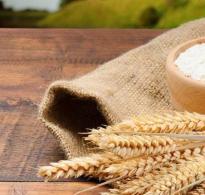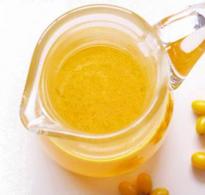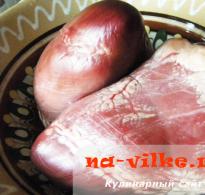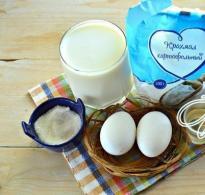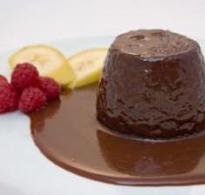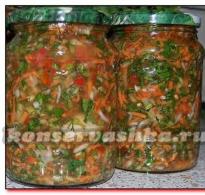How to brew pu-erh correctly - little tricks. What vessel to brew in?
Pu-erh tea is perhaps the most famous (we don't say popular) tea. chinese tea. It is famous, firstly, for the fact that it is made from the leaves not of tea bushes, but of ancient tea trees ( elite varieties), and secondly, by the fact that with age its taste does not weaken, but, on the contrary, intensifies and improves. In this he is similar to the best cognacs and wines.
Some relict tea trees, growing in the only place in China - Yunnan, reach 2700 years in age and thirty meters in height! This region of the Celestial Empire has a special humid climate and special soil, which together are better conditions for the growth of tea trees and the ripening of Pu-erh tea.
It is believed that it was in Yunnan that tea originated and developed as we know it, with a certain metabolism in it.
Of course, for certain subspecies of puer, leaves are also collected from tea bushes. But, collected from trees, leaves can be given away in the future tea drink much more of all kinds useful substances, since in perennial trees they accumulate, of course, much more.
You must understand that the real, one might say legendary, pu-erh is made from the leaves of exclusively straight-trunked tea trees that grow only in Yunnan. There are very few of them, so tea from these trees is simply not available for sale in regular stores. Pu-erhs made from bush tea leaves are more affordable. The first are called Shen pu'er, the second - Shu pu'er. Shu Puerh was invented not so long ago, in the 20th century, so that tea could be used faster. Shen pu-erh takes decades to mature.
Tea has long been exported from China to many countries around the world. There was the so-called Ancient Tea Road, no less important than the Great Silk Road. Along this road, for a very long time, sometimes for years, tea, packaged in the form of large briquettes and wrapped in bamboo leaves, was transported over vast distances. It was noticed that the longer it moved to the consumer, the more consistent its taste became. Much later, scientific research showed that all this time a fermentation process was taking place in tea, which was facilitated by unique properties Yunnan tea trees, and the unique natural conditions in which the tea was escorted to its destination.
It turns out that pu-erh can rightfully be called “living” tea. Certain bacteria live on the tea leaf, and they influence the fermentation of the tea, promoting proper ripening.
True lovers of Chinese Pu-erh tea value it not only for the pleasure it brings, but also for the fact that it promotes longevity and mental concentration.
A few notes before brewing
Do not purchase pu-erh with additives. Good tea does not need them; most likely, flavoring was needed to cover up low-quality tea.
Learn to recognize sheen pu-erh by smell. Good puer smells of dried fruits and black soil. But these smells are barely perceptible.
A tea tile (it can be a brick or a pancake) should not contain voids.
It will be great if you have the opportunity to taste the tea before buying pu-erh. The color of the tea should be rich in pressed tea, not so pronounced in loose leaf; the taste is pleasant, the aroma is fruity, the leaves are straightened during brewing - not torn.
How to brew pu-erh tea correctly
So, we found out that Chinese Pu-erh tea is legendary, noble and quite rare. How to brew pu-erh at home so as not to spoil this precious and expensive drink?
First of all, take care of the water. Spring water is recommended, but since few of us live close to a spring to be able to go and get fresh water, you can take clean bottled water. As a last resort, run your tap water through a filter. Since you are brewing a unique tea, take the trouble to make melt water.
Secondly, buy teapot and tea pairs made from Yixing clay. These are high-quality dishes that will not spoil the taste tea infusion and will not reduce the effect of it regular use. You can also use porcelain or glassware, but never metal. Through the transparent walls of the glass teapot you will see how the tea leaves come to life and how the infusion is saturated with color.

No Chinese tea can be brewed with boiling water. The water should have a temperature of 90-95 degrees. You can use a thermos, where you drain the water immediately after heating.
Pour boiling water over all the dishes you will use for tea drinking, and at the same time they will warm up. Brew loose pu-erh. For 200 ml we take 5-10 grams of dry tea. Plus or minus a tablespoon (that is, a little less or a little more).
Pour boiling water over the tea and drain the water immediately. This is more like cleaning the tea leaves, because the tea has been stored for a long time, in the ground, so we carry out a kind of disinfection. The second purpose of pouring boiling water is to help the tea open.
Now boiled water should cover the tea for three to five seconds. Real tea connoisseurs pour water into the teapot from a height, at which time it is enriched with oxygen. That's it, you can drink.
Brew pressed pu-erh. This type of tea has larger leaves and a denser compaction, so you need to add less tea leaves and brew longer. So, break off a piece of pressed pu-erh, pour in either raw water and let it swell, or hot, but then drain it immediately. After this, pour hot water from a thermos and leave for 7-10 minutes. We drink and enjoy. After three brews, it is recommended to increase the infusion time by 5 seconds.
We brew pu-erh in tablets (they are also called “small nests”). There are small leaves and a very dense pressing.
We soak the tablets and put them in a one and a half liter thermos. Fill with water heated to 95 degrees and leave for one and a half to two hours. Now we need to drink tea as quickly as possible. Otherwise, if left with tea leaves, the tea will become bitter because it will become very strong.
And in a teapot with a volume of up to 250 ml, fill one tablet, soaked with boiling water, with water heated to 90 degrees and leave for 7 minutes. Infuse each subsequent brew 2-3 seconds longer.

They also cook pu-erh. Inexpensive varieties of tea are suitable for this.
Let's prepare a gas burner with an even flame, a kettle, a thermos and a container for soaking the tea leaves.
Turn on the burner and level the flame. Soak the tea leaves. Pour water into the kettle, leaving enough free space, and put it on the fire. Drain off the water in which the pu-erh was soaked. We watch the water. When large bubbles appear, scoop water from the kettle several times and pour it back. This will saturate it with oxygen.
Now use a spoon to make a funnel and pour the soaked tea leaves into it. Brew the tea for about four minutes. Turn off the heat, let it sit for a minute or two and check the taste. If you like the infusion, pour it into cups and drink. If necessary, let it sit longer. It is permissible to dilute over-aged tea with water. But you cannot re-brew cooked pu-erh. Cooking completely extracts everything useful elements in the decoction
There is also a recipe for cooking pu-erh with milk. The technology is the same as on water. Very tasty.
It is also important to clearly see this process.
Remember:
- Never drink pu-erh with confectionery.
- Drink Pu-erh only freshly brewed.
- How better tea, the less time it takes to brew.
Try it different options, choose the best.
True gourmets claim that a cup can shake up routine life good tea. And we have no reason not to believe them. However, for everything to be successful, you need to find “your” drink. It could be, for example, Chinese tea called pu-erh, which is very popular among our compatriots.
It is believed that this unique drink, in addition to its indescribable taste, has the ability to improve mood and energize. But in order to fully experience all the “magic” of pu-erh, you need to brew it correctly, and this is a real art, which, however, is not at all difficult to learn.
High-quality ingredients for a noble drink
The tea itself and the water for brewing must be highest quality– the first rule in the art of making perfect pu-erh.
Choosing puer
The homeland of Puerh is the county of the same name, located in the province of Yunnan. It is here that the best factories in the world for the production of this tea, Menhai and Haiwan, are currently successfully operating. When buying pu-erh produced by specialists from these factories, you can rest assured of its quality.
It is important to know exactly what is in front of you - natural tea from the best manufacturers. In order not to doubt this for a minute, you should buy it in a store with a good reputation, such as “Tea Symphony”: http://zeltea.ru.
There are 2 varieties of pu-erh: Shen - green, raw and Shu - black, ready.
Shen Puer began to be produced in China back in the 8th-9th centuries during the Tang Dynasty. For this tea, only the highest quality raw materials are used - these are the leaves of high-mountain, old trees. The specificity of Shen is that initially the tea leaf has a greenish tint, but over time it darkens under the influence of natural oxidative processes.
In the second half of the 20th century, a technology for accelerated fermentation of tea was developed at the Menhai factory, which gave the world Shu, or black, ready-made pu-erh. It was assumed that for the maximum short time It will be possible to create an analogue of Shen Pu-erh aged for several years. However, according to experts, although the naturally fermented Shen gravitates towards Shu after a few years, it still does not become one - its unique “bouquet” cannot be created artificially.
There is no clear opinion about which is better, Shen or Shu, because this is a matter of individual preference. Usually, beginning aesthetes are advised to try Shu, which has a simpler, more understandable taste, but you can only determine the option that is suitable for yourself by trying each of them.
Pu-erh is available in the form:
- loose leaf tea;
- tea compressed into a pancake, briquette, tablet or tocha (a shape resembling a tea cup).
It is believed that pressed tea has a brighter taste.
Tips for choosing pu-erh on video.
What should be the water for brewing pu-erh?
It should be remembered that when brewing tea, the drink always absorbs taste qualities water. It is very important to use only filtered water, and it is advisable to let the liquid sit for some time.
What to brew pu-erh in
A clay teapot is best suited for brewing pu-erh - such a container has amazing property maintain the temperature required for pu-erh and ensure optimal steaming of tea leaves. For Shu Puer, a porcelain or ceramic gaiwan or even an ordinary teapot is suitable.
So, when everything you need is ready, it’s time to learn the most interesting thing: how to brew pu-erh tea.
Brewing pu-erh: let's look behind the scenes of the sacrament
The process of brewing pu-erh is simple, but it has its own specifics, which are simply necessary to know in order to prepare the tea correctly and fully enjoy its taste.
- The first step is to prepare required quantity puerh. A ratio of 3–5 g of tea per 100–200 ml of water is considered sufficient.
- Now the raw materials are placed in the kettle, but there is no need to rush, first the container should be heated: pour boiling water into it and drain it after about half a minute.
- Now fill the pu-erh with water:
- Shu is a highly fermented tea, so to brew it, the water temperature should be 90-98 °C;
- more delicate Shen requires more delicate handling: the temperature of the water for brewing should be in the range of 85–95 °C, and the older the tea, the higher the temperature.
- Now the liquid from the kettle needs to be drained. Such washing is necessary in order, firstly, to remove dust from the tea leaf, and secondly, to help it open to its maximum.
- After the tea has been rinsed, pour water into the container again. desired temperature for about 10–20 seconds, then pour the finished tea into cups.
Is there a difference between how to brew pressed and loose Pu-erh tea? No, just when using pressed tea, you need to separate the required amount using a pu-erh knife, and if you don’t have one, then an ordinary kitchen knife will do.
Brewing pu-erh tea in tablets or points is even easier: such forms of pressing are usually designed for one-time use.
Tea ceremony or a little about how to drink pu-erh
The best taste of pu-erh is revealed if, before pouring the drink into a cup, you heat it by scalding it with boiling water.
Pu'er - noble drink, you need to drink it without sugar, cream, milk or any sweet snacks. This is the only way to fully experience the unique and unforgettable taste and the aroma of wonderful tea.
Everyone can fill their life with new experiences. So why not find out today what a properly brewed, high-quality pu-erh tastes like?
Watch a video on how to brew this tea correctly.
Has Chinese roots. The most common form of product release is pressed washers. The latter vary in size and are presented in tablets and cakes, the brewing of which is identical. Preparation of the drink in question - complex process. Anyone who decides to try it must ask the question “in tablets?”
What affects the quality of brewed tea?
The concept of “perfect tea” does not exist. Depending on individual preferences, it is different for everyone. It can be a steeply brewed and slightly colored drink, with or without sweeteners, with or without any additives (for example, spices), cold or hot. However, the aspects of achieving maximum flavor and aroma properties remain the same for either option. These include:
- quality of the tea leaves used;
- properties of water;
- utensils used;
- brewing technology.
An interesting feature of pu-erh is that as the brew ages, the taste and healing qualities drinks increase.
Features of pu-erh in tablet form
A tablet is a piece of pressed small tea leaves into a shaped form. The color of the raw material is brown-blue.
A properly prepared drink is characterized by the following features:
- rich brown color;
- moderately thick consistency;
- astringency;
- noticeable notes of chocolate and caramel;
- nutty taste;
- softness and velvety sensation on the palate.
The intensity of astringency can be adjusted by the amount of brewing and infusion time.
This tea in tablets is characterized by a number of healing qualities:
- increased performance digestive system and her recovery;
- facilitating the removal of radionuclides;
- positive effect on the state of the nervous system;
- providing an invigorating effect;
- increasing endurance and performance of the body.
What kind of water should I use?
Tap water contains many unnecessary impurities. The latter may affect taste characteristics tea product, make them dull and less pronounced. Therefore, the main recommendation regarding the issue “in tablets” is to use high-quality filtered water.
Optimal temperature regime determined based on the variety and age characteristics of the tea.
If taste and aromatic properties The resulting tea product seems unopened (not perceptible enough), during the next brewing you should experiment with the temperature of the water (take it a few degrees hotter).
Teapot for brewing
For cooking you will need a teapot. It should be porcelain or glass. Clay options are not recommended. They are characterized by their ability to absorb odors. After one use, the teapot emits aroma for about two weeks. Result:
- you can spoil pu-erh with the smell of previous tea;
- the quality of subsequent brews can be affected by the smell of pu-erh.
The ideal option is to stock up on a separate kettle for the drink in question.

Cooking technology
To extract the maximum valuable qualities It is recommended to prepare the tea in question in tablets as follows:
- preheat the teapot you are using (to do this, simply pour boiling water over it);
- place tablets (xiao to) in it at the rate of one piece per serving;
- crush them carefully (you can use a knife, there is no need to grind them to a powder);
- soak the raw materials in a small amount of boiling water for 10 seconds;
- add water at the recommended temperature;
- leave for 5 seconds;
- separate the grounds;
- bring to the table.
Reuse is possible up to ten times. The infusion time for each subsequent preparation must be increased by a couple of seconds.
Experts often prefer a non-standard cooking method. The latter consists of performing the following steps:
- take a thermos with a capacity of one and a half liters (if this option is not available, you can use others, adjusting the amount of xiao and water used);
- warm up the thermos (pour boiling water over it);
- carefully crush one tablet with a knife;
- soak the raw materials with a small amount of boiling water for 10 seconds;
- place the raw materials in a thermos;
- fill with water at the recommended temperature;
- leave to infuse for an hour and a half.
If the drink is of insufficient concentration, you can:
- double the amount of xiao to;
- extend the infusion time to two hours.
If the pu-erh prepared in this way cannot be drunk within an hour, then the grounds should be separated. Otherwise, noticeable bitterness will appear in the taste.

Use of sugar
Dependence on this sweetener is a common problem. You can add it to the drink in question. However, this will affect the quality of the product: the taste and aroma characteristics will be muted.
Unsweetened drink:
- accelerates metabolic processes;
- lowers cholesterol reserves;
- helps fight excess weight;
- cleanses the body;
- tones and helps fight fatigue.
Experts do not rule out adding dried fruits and dark chocolate to the tea delicacy in question.
Contraindications
- pregnant women;
- children;
- persons with kidney stones (puerh may cause them to move).
Pu-erh tablets are delicious and healthy drink. However, the degree to which this quality manifests itself directly depends on how to brew pu-erh tea in tablets. There are no unimportant aspects in this matter. Everything matters: from the utensils used to the flavoring additives.
There are two main types of Pu'er - Shu-pu'er and Shen-pu'er. To understand how to brew Pu-erh correctly, you need to distinguish between these teas, which, among other things, are produced in loose or pressed form. Loose Sheng Puer is larger, its leaves may have a greenish color. Shu-puer is small, with dark tea leaves. It is prepared using a special fermentation method and has a nutty taste with distinct earthy notes.
Pu-erh tablets (xiaoto) are brewed a little differently than other types of tea. Tea tablets are highly compressed and consist of fine raw materials.
Sequence of actions when brewing:
- To prepare the drink you will need a 1 liter thermos.
- Place 1 tea tablet soaked in boiling water in it and pour hot water with a temperature of about 95°C.
- The tea is steeped for an hour and a half.
- Drain the liquid, separating it from the tea leaves, and drink.
The second time, used tea tablets should not be poured with boiling water. It is believed that they have already given everything valuable to the prepared infusion.
A tea tablet is brewed in a teapot or gaiwan as follows:
- Soak in boiling water for 5 seconds, drain the water.
- Pour boiling water (95°C) for 7 seconds, then pour into bowls and drink.
- At this time, the tablet is again poured with boiling water, increasing the brewing time for the second time by two seconds.
In this way, you can prepare up to 10 brews, during the third and subsequent brewing increases by 15 or 30 seconds each time.
Necessary utensils for brewing tea
To brew Puer, use the following container:
- teapot or gaiwan with a volume of 150 - 250 ml;
- plum or chahai;
- bowls.
The best teapot for brewing is considered to be one made from Isshin clay. It will reveal any tea and especially Pu-erh as well as possible.
Issinsky clay has excellent thermodynamic and porous properties. In such a teapot, even tightly compressed old Pu-erh will give best taste and aroma.
Less often, tea is infused simply in a mug or in a thermos. For brewing by pouring, use a tipot - a kettle with a button.
At what temperature to brew
To brew Pu-erh, you need water at a certain temperature.

It depends on the type of tea chosen:
- Pressed Shu-puer tea is brewed with boiling water at a temperature of 90 – 95°C. The first water must be drained; along with it, all dust and microbes that could accidentally end up in the raw material will go away. The second time, pour boiling water at the same temperature into the tea leaves and leave for several seconds in a closed teapot or gaiwan.
- Sheng Puer tea is poured with hot water at a temperature of 85°C. With further heating, the drink acquires a bitter taste.
- You can also find Pu'er tea in tangerine on sale. This is a tea composition poured inside a dried tangerine. The drink made from it has a special tangerine aroma, which is best revealed at a temperature of 95°C.
How long to brew tea
How much Pu-erh to brew depends on its type and the chosen method of preparation.
Traditionally, washed tea is poured with boiling water for 7 or 10 seconds, the resulting drink is drunk, and then the brewing is repeated 5 to 10 times.
Some tea drinkers prefer brewing with a long exposure - up to several minutes. In this case, the drink can be repeated no more than 2 times.
Method for preparing wild Pu'er
Wild Pu-erh is brewed in several ways, for example, in a mug.

Process description:
- First, heat the dishes with boiling water.
- Drain the water and add Pu-erh at the rate of 4 g per 100 ml of water.
- Pour boiling water (close to 100°C) and leave for 2 minutes.
The disadvantage of this method is that tea leaves may get into your mouth while drinking tea.
In order to brew wild Pu-erh in a gaiwan, the following manipulations are performed:
- Rinse the gaiwan with boiling water.
- Pour tea into it at the rate of 4 g per 150 ml of water.
- Fill with water at a temperature of 95 – 98°C, drain after a second.
- Pour boiling water into the gaiwan again and infuse the tea for a few seconds to 3 minutes, after which the finished drink is poured into bowls.
Use wild Pu-erh in small portions to evaluate its taste and aftertaste.
How to brew loose Pu'er tea
For one serving of Pu-erh, add about 4-5 grams of dry tea leaves and take 150 ml of water.
Sequence of actions:
- In a kettle, heat water to a boil and stir it, creating a circulation.
- Pour in the tea using special tweezers and leave to brew for a few minutes.
- When the tea starts to sink, the drink is ready. You can steep the tea for a few seconds to use the tea leaves several times.
It is not recommended to brew tea from young types of Sheng Puer using this method, since the drink may not be entirely successful. It will be too strong, with a bitter taste.
Strait brewing method
For straight brewing, use a special kettle with a button, or tipot.

Cooking order:
- warm up the kettle and bowl with hot water;
- pour dry tea into the tipot;
- wait a few seconds for it to brew;
- drain the brewed drink and pour into cups;
- repeat brewing the desired number of times.
A tipot teapot or, as it is also called, gongfu, combines two containers in its design, the upper one for brewing tea and the lower one for ready drink. The kettle has a filter that prevents tea leaves from getting into the bowl, and its body is made of heat-resistant glass.
How to brew Puer tea correctly
Tea can be pressed or loose. Pressed Pu-erh needs to be picked out with a knife. For brewing, take clean drinking water, passed through a filter, or key. You cannot take city water from the tap, it will ruin the taste of the drink.
Sequence of actions:
- All dishes - bowls, gaiwan, chahai - are doused with boiling water.
- Pour the prepared tea leaves into a heated kettle and rinse. Correct method brewing requires mandatory rinsing of the brew in hot water before preparing the drink. This allows you to remove dust from dry tea leaves, and also get only the benefits and rich taste from them.
- Then pour boiling water again for 5 seconds or several minutes. It all depends on taste preferences.
- The drink is poured through a strainer into the chakhai and poured into bowls.
They drink Pu-erh slowly, in small sips, pouring the next portion of boiling water into the teapot just before drinking tea.
Unique properties of the drink
Puer tea is the leaves of tea trees from the Yunnan province of China. He extracts from the earth everything valuable that is in it and passes it on to people in a fragrant, amber drink.

Puerh contains a complex of amino acids, vitamins, and microelements that are beneficial for human health.
The unique healing properties of Puerh have been known for a long time.
- It has been proven that its use dilates blood vessels and improves blood circulation in the body. This allows you to reduce all negative, inflammatory processes. Pu-erh does not have a negative effect on the heart, and the tonic effect of the drink is not associated with increased heart rate.
- Drinking tea stimulates muscle and motor activity and gives a boost of energy for several hours. It is advisable to drink it in the first half of the day, before lunch.
- The drink is also useful for intense mental work, as it helps to concentrate, improves attention, memory and perception.
- Puer does not provide negative influence on the gastric mucosa. In this regard, unlike other teas, it is allowed to drink even with peptic ulcers.
- The drink improves metabolic processes, helps remove toxins from the body, and strengthens the immune system.
There are several brewing methods worth trying. Puer tea and choose the one that suits your taste best. There is no need to save money when choosing this type of tea, because good product sold only at the appropriate price.
In this article we will tell you in detail how to properly brew Pu-erh tea using the pouring method - "Ping Cha" and the infusion method in a glass teapot. How you brew pu-erh will determine whether you enjoy your tea or pour bitter, spoiled pu-erh down the sink. You can brew pu-erh in different ways. Some people prefer the traditional pouring method. Someone prepares an infusion in a thermos, mug or kettle.
There are several methods for brewing pu-erh.
Brewing method "Gong Fu Cha" or “highest art” allows you to get maximum pleasure from the tea ceremony. This ceremony will require from you a certain set of Chinese tea utensils, good water and, if possible, the presence of a tea master. However, in everyday life for regular tea drinking, the pour over method is more often used, or "Ping Cha". There are also fans of cooking pu-erh; for them, Lu Yu's method is considered the best option.
Brewing method from "Lu Yuya". In a large teapot, preferably made of tempered glass, in boiling water, a funnel is spun with a spatula or spoon, and pre-washed tea is dropped into the center of it. After the rotation stops, when the tea leaves sink to the bottom, then the pu-erh tea can be considered ready.
How to choose water for brewing tea.
To brew Pu'er tea correctly, we recommend using filtered water or bottled water, because tap water is quite hard and contains various chemicals and minerals that can only harm the taste of tea.
How much tea leaf is needed for brewing?
For one person, 3-5 grams of tea (1-2 teaspoons) per 150 ml of water is enough. Required quantity The easiest way to separate tea from pressed Pu-erh is with a special Pu-erh knife, but you can also use a regular knife or just your hands.
It is better to layer pressed Pu-erh for brewing layer by layer, trying to separate whole leaves, because a small broken leaf can cause the tea to be excessively bitter.
What should the water temperature be?
For brewing Shen and Shu Pu'er should be used different temperatures water. For example, for young Shen Pu'er, up to 3 years of aging, the recommended water temperature is 85-90°C, remove the kettle with boiled water from the stove and wait 3 minutes, the water temperature will be approximately 90°C. For more mature shengs, water at a temperature of 95°C is suitable, and Shu Pu'er It is better to brew with boiling water at 100°C. If you feel that the taste and aroma of the Shen Puer infusion is not rich enough, try adding a little more tea leaves and increase the infusion time, but be careful, otherwise the Shen Puer infusion may become bitter.

What is the best container to brew pu-erh tea in?
Pu-erh can be brewed in a clay teapot, in a glass teapot with a filter glass, in a convenient isipote, in a gaiwan or an ordinary mug, the main thing is to follow some recommendations to get tasty and aromatic tea.


Step-by-step instructions on how to brew pu-erh tea correctly:
Warm up the container before adding tea.

Rinse the dry tea leaves for 5-10 seconds in the kettle and drain immediately.

Drain the first brew.
Washing the tea leaves is necessary to rid the tea of dust, and also allows you to steam dry pressed leaves. Rinsing tea helps to better open the leaf, aroma and taste of the drink.

Pour water into a kettle with steamed tea leaves. The first infusion should be kept for approximately 15-20 seconds. This especially applies to shen puer, otherwise the infusion may be too tart, and if shen puer young (1-2 years of aging), then a little bitter. With each subsequent brew, increase the infusion time to taste.

Once the tea has brewed to the desired strength, immediately pour the tea from the teapot into a separate vessel or directly into cups. If the tea was brewed in a teapot with an infuser or filter glass, then remove the tea leaves (filter) from it, otherwise the infusion will become too tart and may taste bitter, and subsequent brews will be too weak.

Pour the tea into cups. Pu-erh should be drunk slightly cooled, in small sips, this is the only way you will feel all the facets of the tea’s taste and aroma.

How to brew pu-erh so that it sticks?
This is often associated with the so-called “Cha Qi” effect - “the power of tea” or the “tea state”. This largely depends on the quality of the puer, on what tea raw materials are used, for example, puer from ancient tea trees from the village of Lao Ban Zhang “hits the balls” very hard, and of course this applies to shen (green) puer than in shu (black) pu'er. Although some people prefer to achieve the “Cha Tsi” effect by increasing the recommended infusion time, while others believe that they only insert boiled pu-erh. Be that as it may, everyone determines for themselves their favorite varieties and their own convenient method of preparation, the main thing is to listen to yourself and your condition. Whether pu-erh relaxes or inserts is rather a matter of individual perception rather than brewing. Shens tend to be more relaxing. But the same pu-erh can invigorate one person and put another into a state close to tea intoxication.
How to brew pu-erh in a teapot. Video.
How to brew pu-erh in Tipoda. Video.

